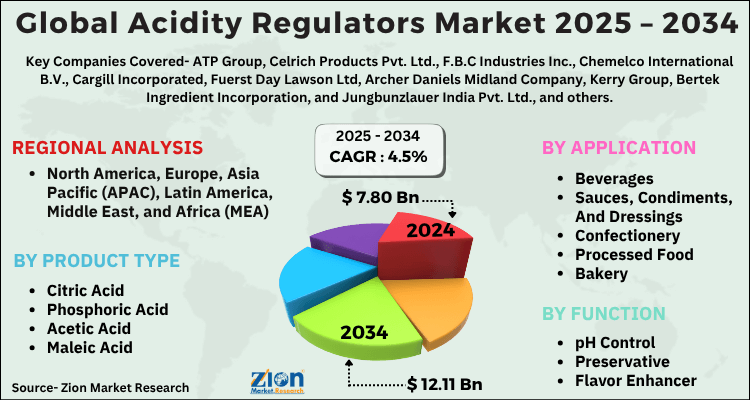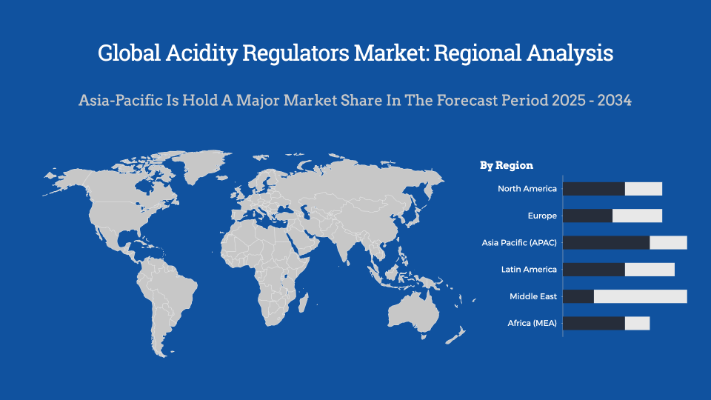Global Acidity Regulators Market Size, Share, Growth Analysis Report - Forecast 2034

Acidity Regulators Market By Product Type (Citric Acid, Acetic Acid, Phosphoric Acid, Lactic Acid, Malic Acid, Others), By Application (Beverages, Bakery & Confectionery, Processed Foods, Sauces & Dressings, Dairy Products), By Function (pH Control, Preservative, Flavor Enhancer), and By Region: Global and Regional Industry Overview, Market Intelligence, Comprehensive Analysis, Historical Data, and Forecasts 2025 - 2034
| Market Size in 2024 | Market Forecast in 2034 | CAGR (in %) | Base Year |
|---|---|---|---|
| USD 7.80 Billion | USD 12.11 Billion | 4.5% | 2024 |
Global Acidity Regulators Market: Industry Perspective
The global acidity regulators market size was worth around USD 7.80 Billion in 2024 and is predicted to grow to around USD 12.11 Billion by 2034 with a compound annual growth rate (CAGR) of roughly 4.5% between 2025 and 2034. The report analyzes the global acidity regulators market's drivers, restraints/challenges, and the effect they have on the demands during the projection period. In addition, the report explores emerging opportunities in the acidity regulators industry.
Global Acidity Regulators Market: Overview
Acid regulators are being utilized more frequently as food additives worldwide to control the acidity and alkalinity in various food products. The term "pH regulating agents" also applies to these acid regulators. They can also be employed as bases, minerals, organic acids, buffering agents, and other chemical compounds. They have a significant impact on the global food and beverage industries. They are used in various products, including dressings and sauces, baked goods, condiments, beverages, candies, and processed foods.
The overall growth of the global market for acidity regulators is expected to be fueled by rising concerns about the average shelf life of food and beverage goods, as well as growing awareness of how microbial action can significantly impact the overall quality of food. It is anticipated that the usage of acidity regulators, which are used to maintain and control the pH balance of food, would increase in the food and beverage industry and bakeries, confectioneries, sauces, spices, and dressings, as well as in food preservatives to extend shelf life. However, the lack of acidity regulators impedes market expansion by causing health issues like diarrhea, nausea, and vomiting.
Global Acidity Regulators Market: Growth Drivers
The use of acidity regulators is expanding in a variety of industries, driving the growth of the market
Acetic acid is a neutralizer and buffering agent in dye baths used in the textile industry. Most customers use this to control the pH level when dyeing fabrics. The most popular organic acid, glacial acetic acid, is frequently used in printing. Contrarily, lactic acid is frequently employed as a mordant in the textile sector. It also controls the chrome level of effluent during the dye application process, improving dye yields. In addition, acetic acid is used in the food business to give food its distinct flavor. It can be used in the food industry as a moderate descaling agent and for the microbiological decontamination of meat.
Additionally, the World Health Organization (WHO) has included acetic acid on its list of essential medications for treating infections of the outer ear caused by bacteria and fungi. As a result, the expansion of the food, pharmaceutical, and textile industries also contributes to the growth of the global acidity regulators market.
Restraints
Acidity regulation overconsumption causes health problems that will impede market expansion
It is predicted that excessive intake of acidity regulators that result in health issues will restrain the global acidity regulators market growth. The impact of the driver is thought to be greater than the restriction. The excessive use of these modulators is thought to be a hindrance to the development of this market since it causes several health issues, including nausea, diarrhea, and an unsettled stomach.
Key Insights
- As per the analysis shared by our research analyst, the global acidity regulators market is estimated to grow annually at a CAGR of around 4.5% over the forecast period (2025-2034).
- Regarding revenue, the global acidity regulators market size was valued at around USD 7.80 Billion in 2024 and is projected to reach USD 12.11 Billion by 2034.
- The acidity regulators market is projected to grow at a significant rate due to rising demand for processed and packaged foods, regulatory compliance for food safety, and consumer preference for clean-label additives.
- Based on Product Type, the Citric Acid segment is expected to lead the global market.
- On the basis of Application, the Beverages segment is growing at a high rate and will continue to dominate the global market.
- Based on the Function, the pH Control segment is projected to swipe the largest market share.
- Based on region, Asia-Pacific is predicted to dominate the global market during the forecast period.
Global Acidity Regulators: Report Scope
| Report Attributes | Report Details |
|---|---|
| Report Name | Acidity Regulators Market |
| Market Size in 2024 | USD 7.80 Billion |
| Market Forecast in 2034 | USD 12.11 Billion |
| Growth Rate | CAGR of 4.5% |
| Number of Pages | 245 |
| Key Companies Covered | ATP Group, Celrich Products Pvt. Ltd., F.B.C Industries Inc., Chemelco International B.V., Cargill Incorporated, Fuerst Day Lawson Ltd, Archer Daniels Midland Company, Kerry Group, Bertek Ingredient Incorporation, and Jungbunzlauer India Pvt. Ltd., and others. |
| Segments Covered | By Product Type, By Application, By Function, and By Region |
| Regions Covered | North America, Europe, Asia Pacific (APAC), Latin America, The Middle East and Africa (MEA) |
| Base Year | 2024 |
| Historical Year | 2020 to 2023 |
| Forecast Year | 2025 - 2034 |
| Customization Scope | Avail customized purchase options to meet your exact research needs. Request For Customization |
Global Acidity Regulators Market: Segmentation
The global acidity regulators market has been segmented into product type, application, function and region. All the segments have been analyzed based on present and future trends and the market is estimated from 2025 to 2034.
Based on product type, the worldwide acidity regulators market is segmented into citric acid, phosphoric acid, acetic acid, maleic acid, and lactic acid. Citric acid accounted for more than 40% of the acidity regulator market in 2024, owing to increased demand in industries such as food & beverages, pharmaceuticals, and others. With their outstanding solubility, agreeable flavor, and pH characteristics, citrus acids are much sought after. Citric acid's excellent sequestering characteristics complete these products' properties and make them suitable for various industries, including food & beverage, medicines, and personal care.
Based on application, the worldwide acidity regulators market is segmented into beverages, sauces, condiments, dressings, confectionery, processed food, and bakery. In 2024, the processed food sector held the greatest market share, accounting for more than 40% of the total market. Additionally, the market is being driven forward by the rising use of lactic acid in the fermentation process of dairy products, including yogurt, cheese, buttermilk, and other dairy products during the manufacturing stage. At the same time, the expanding e-commerce industry, growing population, and increased demand for food all add to the market's expansion.
By Function, the global acidity regulators market is split into pH Control, Preservative, Flavor Enhancer.
The Regional, this segment includes the current and forecast demand for North America, Europe, Asia Pacific, Latin America,and the Middle East and Africa.
Global Acidity Regulators Market: Regional Analysis
The acidity regulators market exhibits diverse regional dynamics, with Asia-Pacific leading due to its large food and beverage industry, growing population, and increasing demand for processed and convenience foods. North America follows, driven by strict food safety regulations and rising consumer preference for clean-label and functional food products. In Europe, stringent regulatory standards and a strong focus on natural ingredients are fueling market growth, particularly in bakery, confectionery, and beverage applications. Meanwhile, regions like Latin America and the Middle East & Africa are experiencing gradual growth, supported by urbanization, expanding food processing sectors, and changing dietary habits, contributing to the overall global expansion of the acidity regulators market.
Global Acidity Regulators Market: Competitive Landscape
Some of the main competitors dominating the global acidity regulators market include;
- ATP Group
- Celrich Products Pvt. Ltd.
- F.B.C Industries Inc.
- Chemelco International B.V.
- Cargill Incorporated
- Fuerst Day Lawson Ltd
- Archer Daniels Midland Company
- Kerry Group
- Bertek Ingredient Incorporation
- Jungbunzlauer India Pvt. Ltd.
Global Acidity Regulators Market: Segmentation Landscape
Acidity Regulators Market is segmented as follows:
By Product Type
- Citric Acid
- Phosphoric Acid
- Acetic Acid
- Maleic Acid
- Lactic Acid
By Application
- Beverages
- Sauces, Condiments, And Dressings
- Confectionery
- Processed Food
- Bakery
By Function
- pH Control
- Preservative
- Flavor Enhancer
Global Acidity Regulators Market: Regional Segment Analysis
- North America
- The U.S.
- Canada
- Mexico
- Europe
- France
- The UK
- Spain
- Germany
- Italy
- Rest of Europe
- Asia Pacific
- China
- Japan
- India
- Australia
- South Korea
- Rest of Asia Pacific
- The Middle East & Africa
- Saudi Arabia
- UAE
- Egypt
- Kuwait
- South Africa
- Rest of the Middle East & Africa
- Latin America
- Brazil
- Argentina
- Rest of Latin America
Table Of Content
Methodology
FrequentlyAsked Questions
Acid regulators are being utilized more frequently as food additives worldwide to control the acidity and alkalinity in various food products. The term "pH regulating agents" also applies to these acid regulators. They can also be employed as bases, minerals, organic acids, buffering agents, and other chemical compounds. They have a significant impact on the global food and beverage industries. They are used in various products, including dressings and sauces, baked goods, condiments, beverages, candies, and processed foods.
The global acidity regulators market is expected to grow due to rising demand for processed and packaged foods, regulatory compliance for food safety, and consumer preference for clean-label additives.
According to a study, the global acidity regulators market size was worth around USD 7.80 Billion in 2024 and is expected to reach USD 12.11 Billion by 2034.
The global acidity regulators market is expected to grow at a CAGR of 4.5% during the forecast period.
Asia-Pacific is expected to dominate the acidity regulators market over the forecast period.
Leading players in the global acidity regulators market include ATP Group, Celrich Products Pvt. Ltd., F.B.C Industries Inc., Chemelco International B.V., Cargill Incorporated, Fuerst Day Lawson Ltd, Archer Daniels Midland Company, Kerry Group, Bertek Ingredient Incorporation, and Jungbunzlauer India Pvt. Ltd., among others.
The report explores crucial aspects of the acidity regulators market, including a detailed discussion of existing growth factors and restraints, while also examining future growth opportunities and challenges that impact the market.
RelatedNews
HappyClients
Zion Market Research
Tel: +1 (302) 444-0166
USA/Canada Toll Free No.+1 (855) 465-4651
3rd Floor,
Mrunal Paradise, Opp Maharaja Hotel,
Pimple Gurav, Pune 411061,
Maharashtra, India
Phone No +91 7768 006 007, +91 7768 006 008
US OFFICE NO +1 (302) 444-0166
US/CAN TOLL FREE +1 (855) 465-4651
Email: sales@zionmarketresearch.com
We have secured system to process your transaction.
Our support available to help you 24 hours a day, five days a week.
Monday - Friday: 9AM - 6PM
Saturday - Sunday: Closed







